- Partner Grow
- Posts
- Thinking Machines Lab: The $2B Moonshot To Redefine Multimodal AI
Thinking Machines Lab: The $2B Moonshot To Redefine Multimodal AI
Thinky $2B seed
👋 Hi, it’s Rohit Malhotra and welcome to the FREE edition of Partner Growth Newsletter, my weekly newsletter doing deep dives into the fastest-growing startups and S1 briefs. Subscribe to join readers who get Partner Growth delivered to their inbox every Wednesday morning.
Latest posts
If you’re new, not yet a subscriber, or just plain missed it, here are some of our recent editions.
Partners
Interested in sponsoring these emails? See our partnership options here.
Join 400,000+ executives and professionals who trust The AI Report for daily, practical AI updates.
Built for business—not engineers—this newsletter delivers expert prompts, real-world use cases, and decision-ready insights.
No hype. No jargon. Just results.
Subscribe to the Life Self Mastery podcast, which guides you on getting funding and allowing your business to grow rocketship.
Previous guests include Guy Kawasaki, Brad Feld, James Clear, Nick Huber, Shu Nyatta and 350+ incredible guests.
Housekeeping
Today’s post is a little different.
Instead of our usual deal tear-downs, we’re diving into something earlier-stage—but equally electric.
I’ve been exploring a wave of AI startups that aren’t just promising—they’re investable. And I’m now expanding into Thinky’s seed round, one of the most exciting bets of 2025.
Let’s break down what makes Thinky worth paying attention to.
Thinky’s $2B seed round
In early 2025, Mira Murati, the former CTO of OpenAI and interim CEO during its most volatile chapter, left to start something new: Thinking Machines Lab, or "Thinky" as it’s already affectionately known in AI circles. Six months later, the company announced a $2 billion seed round at a $12 billion valuation, the largest in venture history by an extraordinary margin.
It would be easy to dismiss Thinky as hype-driven vaporware. No product. No public demos. No official research. But the company is more than a stealth-mode bet—it’s a brain trust of OpenAI and DeepMind alumni building a new kind of AI lab focused on open science, customizability, and multimodal fluency.
"We're not building a chatbot. We're building infrastructure for the next generation of human-AI collaboration," Murati wrote in July 2025.
The question now: can Thinky translate a monster seed round and the most elite team in AI into a new paradigm before the hype clock runs out?
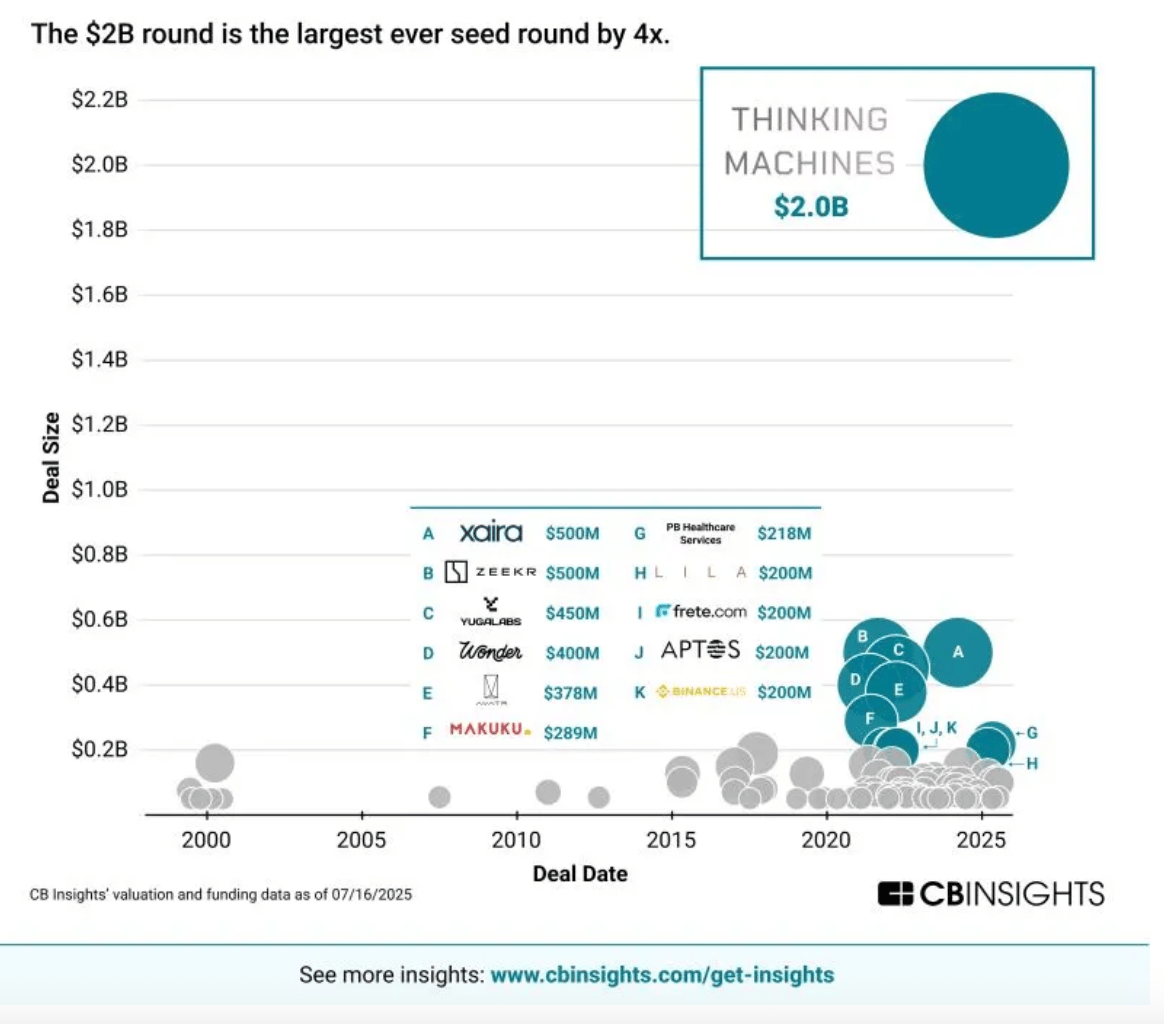
Market Opportunity
Thinky is attacking a $100B+ opportunity at the intersection of infrastructure, openness, and multimodal intelligence. Its strategic bets align with major shifts underway in enterprise demand, AI research, and geopolitics.
LLM Infrastructure: Enterprises increasingly want to own their models—not just rent intelligence via API. Thinky’s open-weight foundation models cater to this demand for control, auditability, and customization. Think of it as the AWS of open models: configurable, secure, and adaptable to a company's proprietary data and domain needs.
Open-Weight Demand: The tide is turning against closed-source giants. With OpenAI, Google, and Meta tightening access, a vacuum has emerged for transparent, inspectable, and modifiable models. Open-weight models like those from Mistral and Falcon are gaining traction, but no one has cracked multimodal, modular, and enterprise-ready in one stack. Thinky is positioning itself as that full-stack solution.
Multimodal Platforms: AI is no longer just about text. We’re seeing a convergence across language, vision, audio, and code. While legacy labs retrofit multimodal capabilities onto language-first models, Thinky is building natively multimodal from day one. This opens doors to new applications in healthcare, robotics, industrial design, scientific research, and creative tooling—areas where text alone isn’t enough.

But the opportunity isn’t just technical. It’s geopolitical.
Governments and enterprises worldwide are pursuing sovereign AI—technologies that are open, auditable, and hostable within national borders. The EU’s AI Act, India’s public infrastructure push, and Japan’s support for open models are all part of this shift. Thinky is one of the few U.S. companies aligned with these principles.
Backing from NVIDIA, itself a vocal supporter of sovereign AI, underscores this strategic alignment. So does the interest from Asian and European funds who view Thinky not just as a product bet, but as infrastructure for a more multipolar AI ecosystem.
Thinky is skating to where the puck is going: a world where companies and countries demand powerful, flexible, open AI systems—not just subscriptions to someone else’s black box.
I started Thinking Machines Lab alongside a remarkable team of scientists, engineers, and builders. We're building three things:
- Helping people adapt AI systems to work for their specific needs
- Developing strong foundations to build more capable AI systems
- Fostering a— Mira Murati (@miramurati)
6:33 PM • Feb 18, 2025
Product (What we know so far)
Thinky has not released a product—yet. But Mira Murati has hinted at what’s to come: a multimodal, open-source-friendly foundation model engineered from the ground up for human-AI collaboration—not just interaction.
Early signals suggest that Thinky is not chasing the next ChatGPT clone. Instead, the company is likely focused on building modular, voice-native systems that excel across text, vision, and speech, with an emphasis on assistive reasoning and creativity.
This could mean:
An open-weight foundation model that can be adapted to specific verticals or use cases, such as biotech research, industrial design, or creative storytelling.
Cross-modal reasoning, where a user might upload a diagram, describe a problem verbally, and get back structured insights, designs, or simulations in multiple formats.
Voice-first interaction, enabling users to converse naturally with the model in ways that transcend typing prompts or clicking buttons—something closer to a collaborative partner than a digital assistant.
Custom agent creation, where teams can fine-tune and deploy models tailored to their workflows, tools, and data—without needing hundreds of engineers or proprietary APIs.
Thinky's approach echoes the early ethos of computing itself: tools for augmenting human intelligence, not replacing it. This is a departure from the generalist, black-box LLMs dominating today’s landscape.
If successful, Thinky’s first product won’t just compete with existing models—it could redefine how we think about foundation models altogether.
Business Model
Still in formation, but hints point to three emerging pillars:
Foundational Model Licensing
Thinky is expected to offer large, multimodal foundation models under an open-weight license. What makes this unique is the focus on customizable architectures—giving enterprises and governments the ability to adapt models to proprietary datasets, workflows, or safety constraints. Unlike black-box APIs from OpenAI or Anthropic, Thinky’s approach could let customers tune or even retrain the base models, making it appealing for high-stakes sectors like healthcare, defense, and advanced research.Enterprise AI Infrastructure
There are early signs that Thinky may become a platform company, not just a model shop. This could include tooling for model training, fine-tuning, inference, and orchestration—especially for multimodal pipelines that span language, vision, and voice. In essence: Thinky could offer a full-stack foundation for companies to build domain-specific AI systems on open infrastructure.Research-as-a-Platform
Internally, Thinky seems inspired by open-source culture and scientific reproducibility. Over time, it may evolve into a kind of GitHub or Hugging Face for cutting-edge AI research—where researchers can share, remix, and build upon each other’s models and datasets. If Thinky builds modular, interoperable components (e.g. training loops, eval sets, synthetic data generators), it could become the default interface for collaborative AI science.
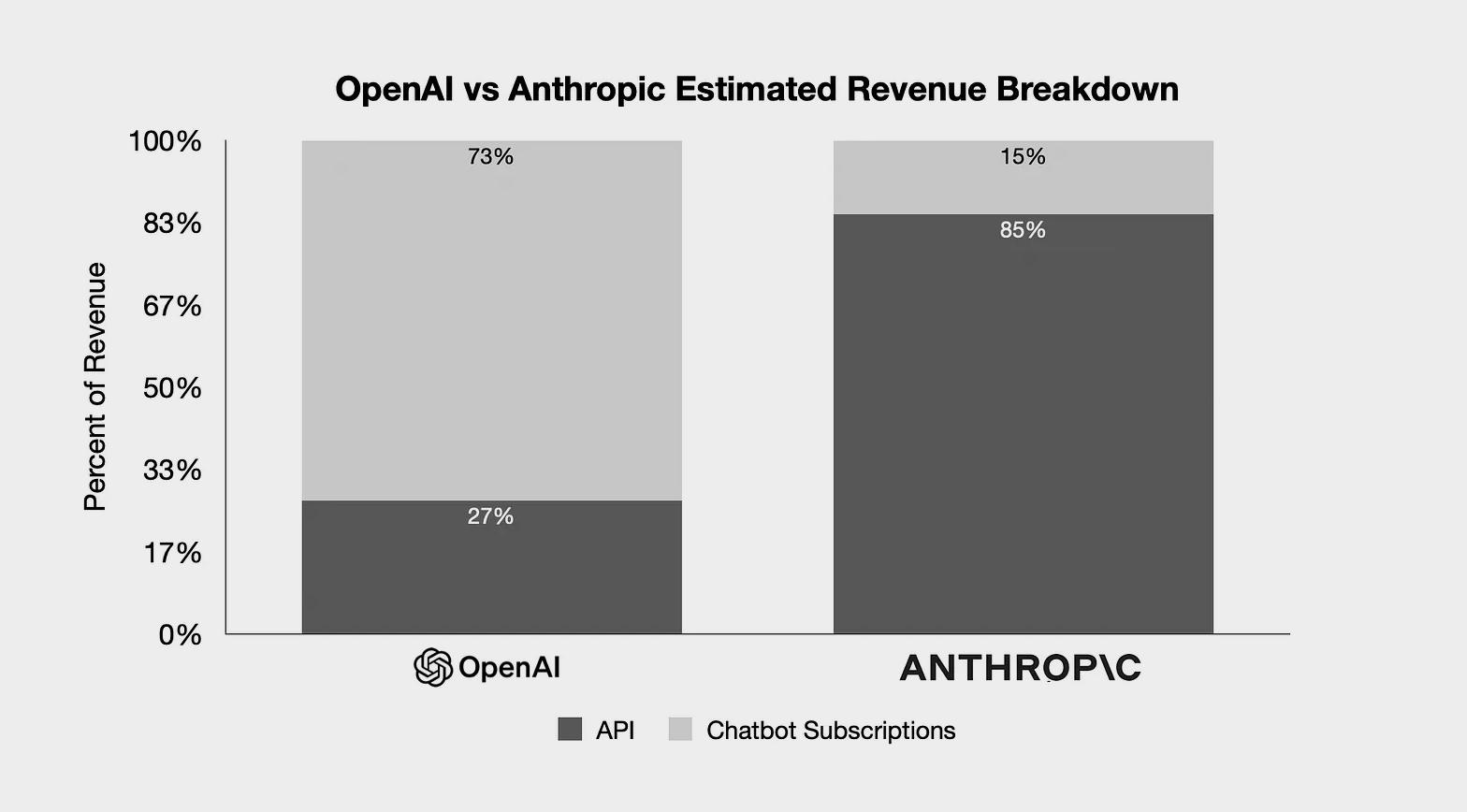
Thinky’s monetization may blend:
Hugging Face’s community-led openness and ecosystem-building
OpenAI’s enterprise-scale foundation model licensing
Anthropic’s tooling around alignment, safety, and fine-tuning
But all under a deeply pro-science, open-by-default philosophy that could position it as the go-to infrastructure for sovereign and enterprise-grade AI.
Management Team:
This isn’t just a star founder story. Thinky has quietly assembled one of the densest concentrations of elite AI researchers anywhere in the world—perhaps rivaling DeepMind and OpenAI in their earliest days.
Mira Murati, CEO – Former CTO of OpenAI and interim CEO during its most turbulent chapter. Architect behind ChatGPT, DALL·E, and key initiatives around safety and deployment. Her leadership combines technical insight with organizational experience in scaling frontier AI.

John Schulman, Chief Scientist – Co-founder of OpenAI, co-creator of Proximal Policy Optimization (PPO), and one of the most cited researchers in modern reinforcement learning and alignment research. He’s shaping Thinky’s scientific agenda from first principles.
Barret Zoph, CTO – Former head of research at OpenAI, previously at Google Brain where he helped pioneer Neural Architecture Search (NAS). A rare blend of deep systems thinking and frontier model innovation.
Alexander Kirillov, Head of Multimodal Research – Led OpenAI’s work on vision-language models. A defining force behind the fusion of text, image, and video intelligence—now building the next wave of multimodal systems at Thinky.
Luke Metz, Devendra Chaplot, Lilian Weng – Veterans of DeepMind, Anthropic, Meta AI, and Mistral. Each has led groundbreaking work in areas like agent-based learning, embodied AI, interpretability, and open-source LLM safety.
Nearly two-thirds of the team are former OpenAI researchers, many of whom worked on GPT, CLIP, or Codex. But unlike typical alumni startups, this is not a founder-plus-junior-engineers configuration—it’s a concentrated, high-autonomy group of principal scientists, systems engineers, and long-term thinkers.
The density of senior research talent at Thinky may be unprecedented outside Big Tech. It’s not just about who’s here—it’s about what they can build together, unencumbered by corporate constraints, with $2 billion of dry powder and a shared belief in open science.
Meta CEO Mark Zuckerberg tried to acquire Thinky just months ago. When CEO Mira Murati declined, Meta launched an aggressive recruiting campaign, targeting over a dozen of Thinky’s ~50 employees. Their top prize? Co-founder Andrew Tulloch, a decorated Australian engineer and former Meta and OpenAI leader.
Zuckerberg and Meta Superintelligence chief Alexandr Wang reportedly offered Tulloch a package worth up to $1.5 billion over six years. Tulloch said no. Not a single employee left.
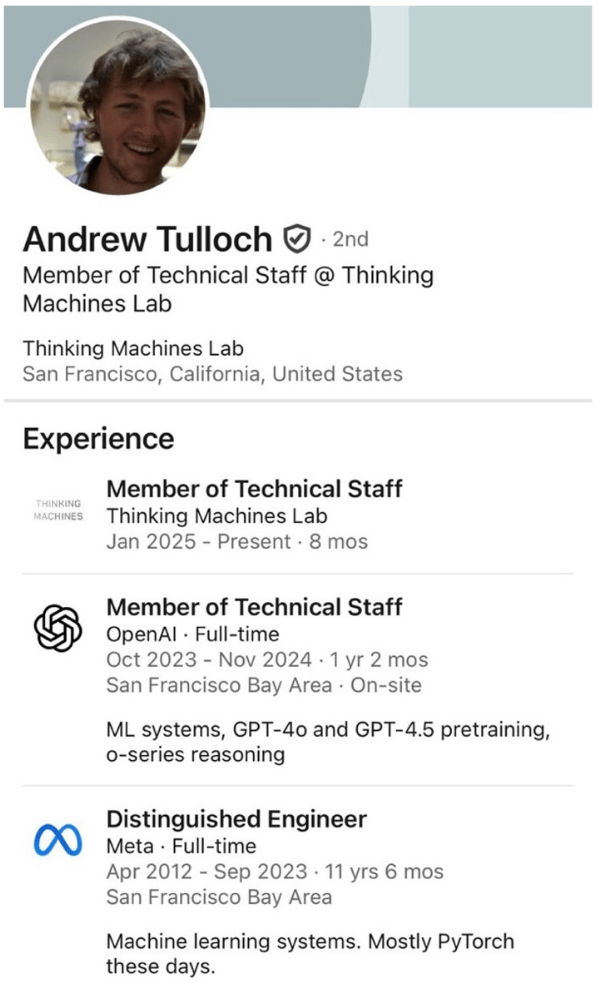
OpenAI-Alum Effect
Thinking Machines Lab isn’t just another startup with OpenAI DNA—it’s arguably the most densely packed OpenAI alum team outside of OpenAI itself. With Murati, Schulman, Zoph, and Kirillov all holding leadership roles, and advisors and engineers joining from the earliest days of ChatGPT and DALL-E development, this is a founding team that understands both the frontier and the stakes.
It resembles Anthropic in its early days—founded by OpenAI researchers with a strong emphasis on safety and alignment. But with a clearer cap table and a sharper sovereign vision.
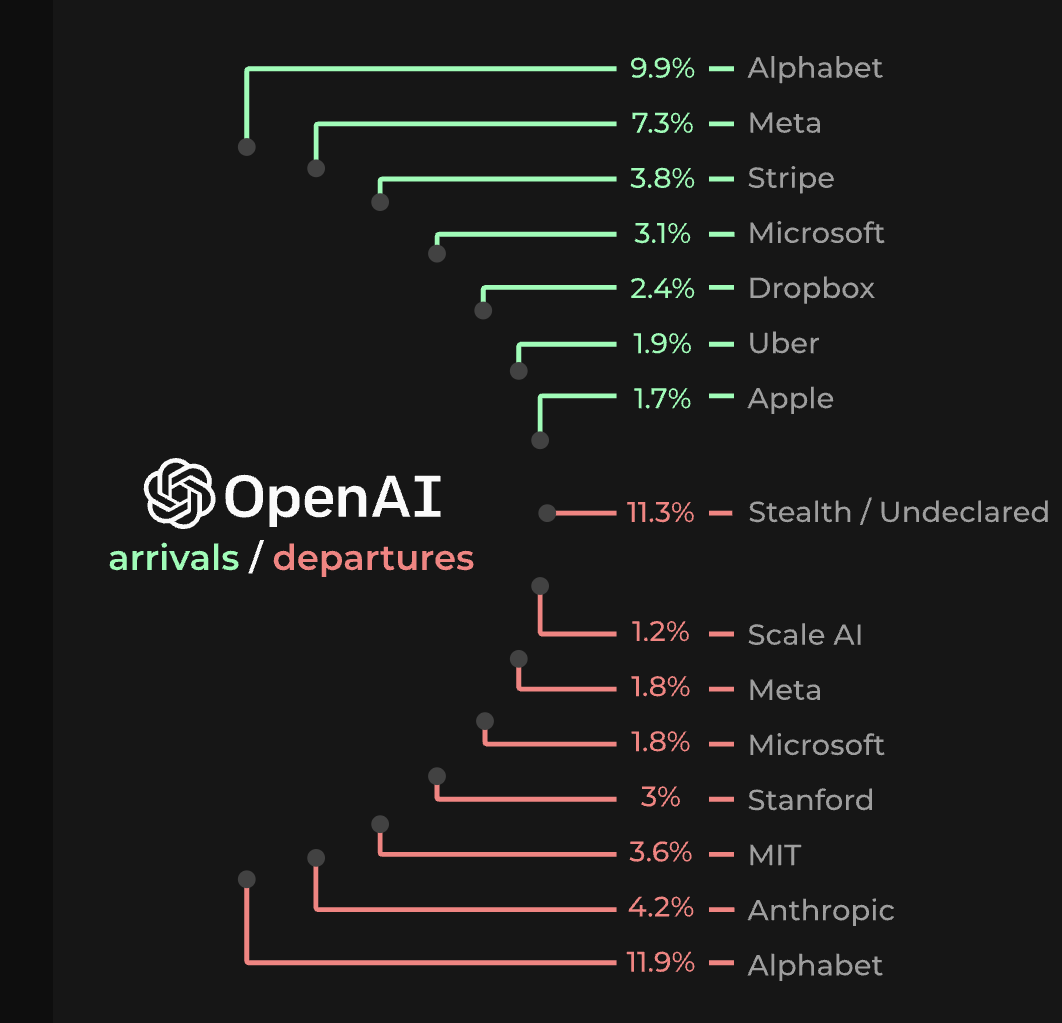
Investment
Thinky’s backers read like a who’s who of AI capital, infrastructure dominance, and enterprise reach—each investor representing a strategic pillar of what it takes to build and distribute the next foundational model layer.
Andreessen Horowitz (a16z) – Lead investor and long-time backer of bleeding-edge bets at the convergence of AI and software infrastructure. Their support signals high-conviction belief in both Murati’s leadership and Thinky’s ambition to reshape foundational models.
NVIDIA & AMD – The two dominant players in AI chips, backing the same company suggests Thinky is expected to drive significant GPU demand—and possibly design its own compute stack or fine-tuning infrastructure to optimize cost and performance at scale.
Accel, Cisco, ServiceNow, Jane Street, GV Ventures – A diverse mix that spans early-stage scaling (Accel), enterprise infrastructure (Cisco, ServiceNow), and high-performance quantitative computing (Jane Street). These aren’t passive investors—they represent potential customers, distribution channels, and go-to-market allies.

Conviction Partners (Sarah Guo), Albanian Investment Corporation, Ambush Capital – Emerging but increasingly influential funds backing frontier AI, moonshots, and sovereignty-aligned infrastructure plays.
The $2 billion may sound absurd on the surface—especially for a company with no public product—but it reflects a clear pattern: this isn’t a standard venture investment. It’s a geopolitical and technological bet on a new AI lab that wants to be part Hugging Face, part DeepMind, and part GitHub.
In a market increasingly shaped by compute access, trust, and openness, Thinky is being positioned as a strategic hedge—against OpenAI’s closed loop, Anthropic’s safety-first narrowness, and Meta’s platform risk.
Nvidia investment
When NVIDIA joins your cap table this early, it means something.
The GPU giant typically comes in later—but TML is one of the rare exceptions. In fact, it’s one of the only seed-stage companies NVIDIA has ever backed directly. This speaks volumes about the strategic alignment between TML’s mission and NVIDIA’s thesis for the future of AI.
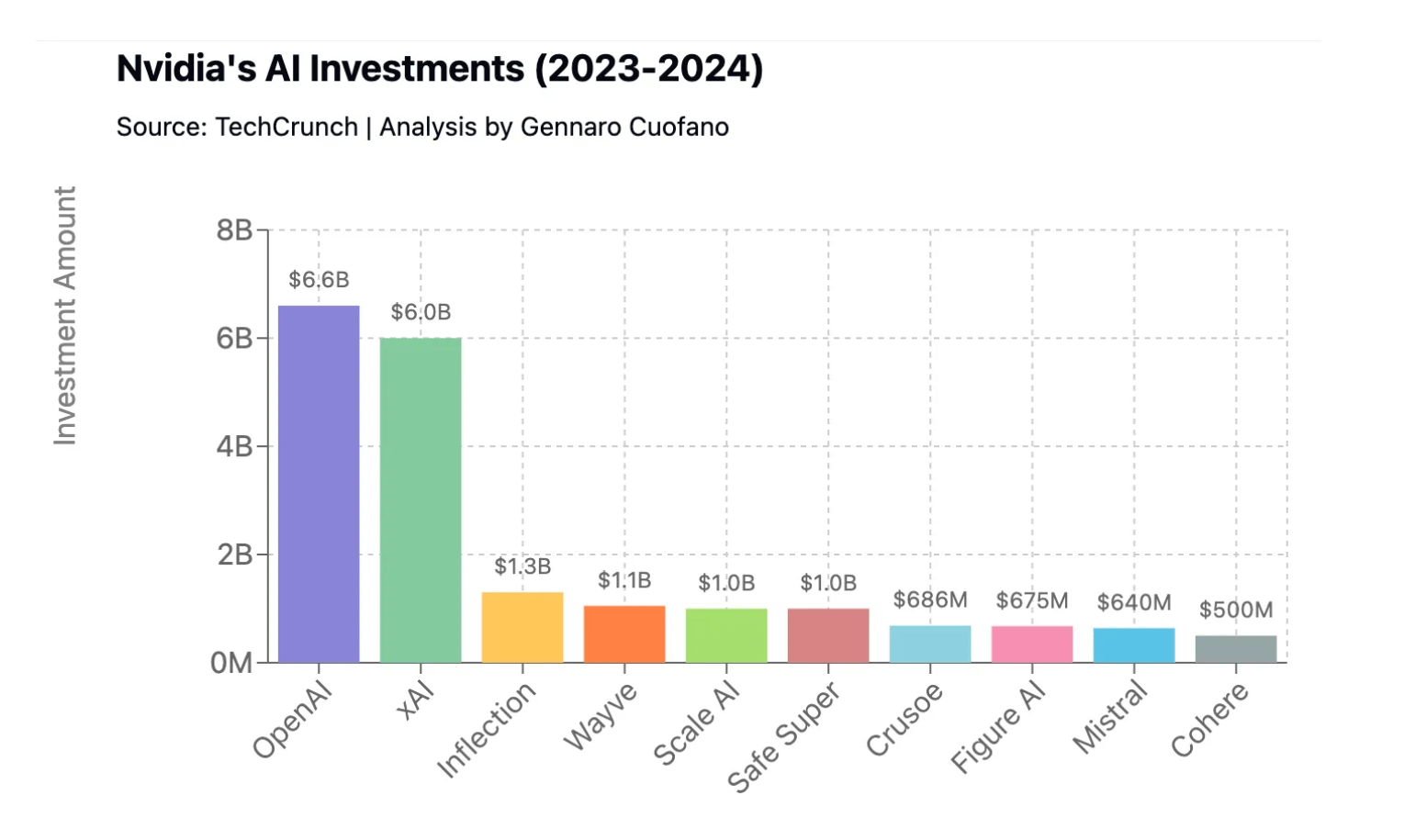
Why it matters:
NVIDIA’s AI capital isn’t scattershot. It’s concentrated. Every major investment—CoreWeave (infra), Hugging Face (dev tooling), Mistral & Together AI (open-weight models), Figure AI (robotics), Perplexity (consumer AI)—supports a sovereign and open AI ecosystem.
TML fits this mold perfectly. Not only are they building in the open-weight direction, they’re free from hyperscaler entanglements—unlike OpenAI (Microsoft), Anthropic (Amazon + Google), or xAI (Tesla + Twitter).
Sovereign AI isn’t just branding. It’s an emerging doctrine: countries, enterprises, and developers increasingly want transparent, locally deployable models. NVIDIA is the arms dealer of this movement. TML may become one of its most powerful vehicles.
This investment echoes NVIDIA’s other high-conviction bets:
Mistral AI – Open-weight LLMs, Europe-based, now valued at $6B+
Together AI – Infrastructure and models, raised $100M+ from NVIDIA and others
Hugging Face – Developer hub of the AI world, hosting 1M+ models and datasets
Figure AI, Wayve, CoreWeave – Enablers of verticalized or accelerated AI deployment
TML is now in that rarefied group—despite being just months old.
Risks
Timing risk: Thinky needs to ship something world-class, soon. Every month without a demo increases the pressure and raises skepticism, especially with rivals accelerating.
Overcapitalization: $2B is a blessing and a burden. It creates high expectations and little room for incremental progress. With no product or revenue, the company risks becoming a lightning rod for media scrutiny and internal drift.
Competition: OpenAI, Anthropic, Mistral, xAI, Meta Superintelligence Lab. All are shipping models, winning mindshare, and attracting top researchers. Thinky is entering a crowded battlefield.
Talent retention: With a team this senior and ambitious, internal cohesion matters. Misalignment on strategy or pace could lead to high-profile exits and instability.
Regulatory environment: Any open-weight LLM company must navigate safety, misuse, and export control issues. With regulators increasingly focused on transparency and governance, Thinky's pro-open stance may draw both fans and watchdogs.
Closing thoughts
Thinking Machines Lab isn't just another AI startup riding the hype cycle. It’s a bold bet on open-weight, modular, and sovereign AI—built by insiders who’ve shaped the field and backed by investors who rarely misfire.
Yes, there are risks: timing pressure, enormous expectations, fierce competition. But this is also the kind of company that rewrites the rules.
In a landscape increasingly shaped by cloud monopolies and closed models, Thinky is a high-conviction wager on the next GitHub of AI science. Not a tool. A platform. Not a product. A paradigm.
If it executes, this could be one of the most important startups of the 2020s.
Here is my interview with Dario De Wet is a VC investor and founder of LTV Capital, and managing director at Monza Group International. He has previously led investments at Anthemis Group.
In this conversation, Dario and I discuss:
What separates true investors from “asset gatherers” in venture capital?
Given the current IPO market resurgence, what factors actually matter for companies going public?
Are billion-dollar valuations today a sign of real strength, or mostly hype?
If you enjoyed our analysis, we’d very much appreciate you sharing with a friend.
Tweets of the week
The best business school is… being in business.
— Codie Sanchez (@Codie_Sanchez)
3:27 PM • Aug 1, 2025
The best way to improve your writing is to spend more time listening.
— Kieran Drew (@ItsKieranDrew)
12:43 PM • Aug 1, 2025
The hack from 1990-2020 was increasing digital time. You got ahead of the competition. The current hack is increasing analog time because it’s extremely rare. Walks without a phone. Carry a notepad. Fly in for meetings. Write a physical letter. Stare at a wall. 3D mode.
— George Mack (@george__mack)
7:35 PM • Jul 31, 2025
Major life cheat code: Stop assuming who the "experts" are. Some of the best lessons come from people you least expect. An intern who questions your system, a junior hire who’s a little too honest, a stranger with no agenda. Insight is everywhere, if you’re open to hearing it.
— Blake Burge (@blakeaburge)
12:19 PM • Jul 30, 2025
The path to solving hunger, disease and poverty is AI and robotics
— Elon Musk (@elonmusk)
5:53 PM • Jul 30, 2025
Here are the options I have for us to work together. If any of them are interesting to you - hit me up!
Sponsor this newsletter: Reach thousands of tech leaders
Upgrade your subscription: Read subscriber-only posts and get access to our community
Subscribe to the Life Self Mastery podcast, which guides you on getting funding and allowing your business to grow like a rocketship.
And that’s it from me. See you next week.


Reply